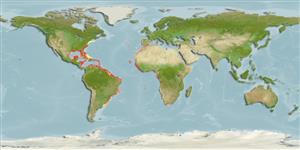Teleostei (teleosts) >
Tetraodontiformes (Puffers and filefishes) >
Ostraciidae (Boxfishes)
Etymology: Acanthostracion: Greek, akantha = thorn + Greek, ostrakon = shell (Ref. 45335); quadricornis: Specific name refers to the 2 pairs of horns ('quadricornis' = 4 horns), in front of the eyes and a second pair at the lower rear corners of the cuirass..
More on author: Linnaeus.
Environment: milieu / climate zone / depth range / distribution range
Ecology
Marine; reef-associated; depth range 1 - 80 m (Ref. 26938), usually 10 - 30 m (Ref. 40849). Subtropical; 43°N - 39°S, 100°W - 26°E
Atlantic Ocean: in tropical and temperate waters (Ref. 3696). Western Atlantic: Massachusetts (USA), Bermuda, and northern Gulf of Mexico to southeastern Brazil. Reported from tip of South Africa.
Length at first maturity / Size / Weight / Age
Maturity: Lm 22.2, range 17 - ? cm
Max length : 55.0 cm TL male/unsexed; (Ref. 6937); common length : 20.0 cm TL male/unsexed; (Ref. 3696)
Dorsal spines (total): 0; Dorsal soft rays (total): 10; Anal spines: 0; Anal soft rays: 10. Dark markings on head and body; parallel bands on cheek. Pair of prominent spines projecting from in front of eyes suggests cow horns. Second pair of spines at lower rear corners of cuirass (Ref. 26938). Body deep, covered with hexagonal dermal plates (Ref. 37521).
Found in shallow water down to about 80 m, mainly in seagrass beds (Ref. 3696). Feeds on sessile invertebrates such as tunicates, gorgonians and anemones, as well as on slow-moving crustaceans, sponges (Ref. 3696), hermit crabs and marine plants (Ref. 13442). Oviparous (Ref. 205). Considered an excellent food fish; marketed fresh (Ref. 3696).
Smith, M.M., 1986. Ostraciidae. p. 890-893. In M.M. Smith and P.C. Heemstra (eds.) Smiths' sea fishes. Springer-Verlag, Berlin. (Ref. 3141)
IUCN Red List Status (Ref. 130435)
Threat to humans
Reports of ciguatera poisoning (Ref. 30303)
Human uses
Fisheries: minor commercial; aquarium: commercial
Tools
Special reports
Download XML
Internet sources
Estimates based on models
Preferred temperature (Ref.
123201): 22.3 - 28, mean 25.4 °C (based on 458 cells).
Phylogenetic diversity index (Ref.
82804): PD
50 = 0.5625 [Uniqueness, from 0.5 = low to 2.0 = high].
Bayesian length-weight: a=0.03981 (0.02306 - 0.06873), b=2.70 (2.54 - 2.86), in cm total length, based on LWR estimates for this species & (Sub)family-body (Ref.
93245).
Trophic level (Ref.
69278): 2.7 ±0.2 se; based on diet studies.
Resilience (Ref.
120179): High, minimum population doubling time less than 15 months (Fec = 112,536).
Fishing Vulnerability (Ref.
59153): Moderate vulnerability (42 of 100).
Nutrients (Ref.
124155): Calcium = 22.3 [9.0, 63.2] mg/100g; Iron = 0.615 [0.308, 1.471] mg/100g; Protein = 18.8 [16.5, 21.0] %; Omega3 = 0.153 [0.077, 0.296] g/100g; Selenium = 24 [10, 55] μg/100g; VitaminA = 18.4 [4.2, 81.7] μg/100g; Zinc = 0.73 [0.46, 1.17] mg/100g (wet weight);
